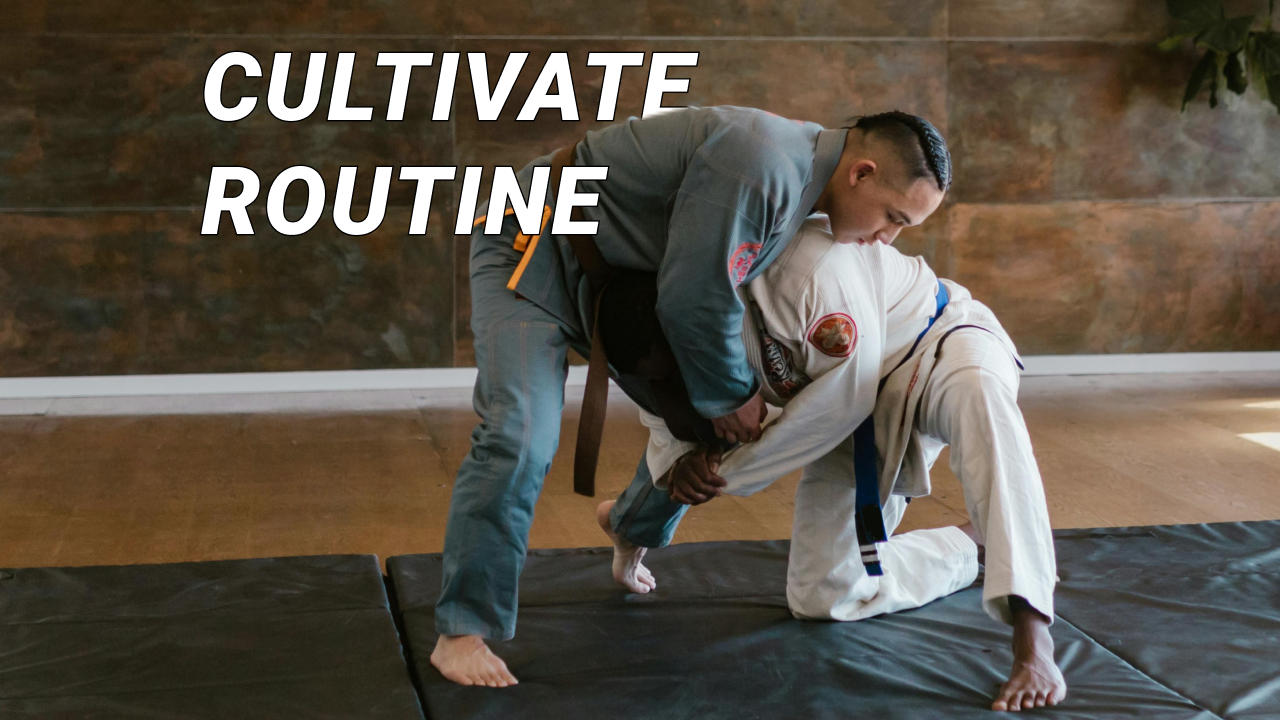Cultivate Routine

Getting to the level of black belt is no easy task. Even in the best-case scenario, it takes between one and two years to advance from one belt to the next, and those who reach the level of black belt typically have dedicated close to a decade to their jiu-jitsu training.
When something takes ten years to accomplish, skill development is really only part of the equation. One also has to stay healthy by eating well, conditioning, and getting sufficient rest. One also has to avoid injuries sustained while training, since serious injuries can mean months away from the mat and potentially an even longer absence from tournaments.
Additionally, one has to juggle other responsibilities like work and family. This may not be that difficult when one is still single and in their early 20s, but the same is not true when one is 33 with a spouse, two kids, and a mortgage. In order to stay on the right track, you need to become a creature of habit and strict routine.
In the above video, Coach Firas Zahabi of Tristar Gym in Montreal talks about some of the ways he manages to stay healthy and to stay dedicated to training.
Practice Etiquette
Training is a form of preparation. When a person is training, they are preparing themselves to fight in a tournament or to survive an altercation. Whether conditioning by going for a five-mile run or rolling during jiu-jitsu class, the goal is to become a more capable fighter by increasing one’s stamina, strength, or skill.
One thing training is not is not a matter of life or death. This is something to constantly keep in mind when rolling with a partner. If you put your partner in a submission hold, give them a few seconds to tap. Don’t immediately apply full pressure or seriously try to choke them out. You should expect the same courtesy from your partner. If they insist on going full barbarian all the time, find another partner.
While rolling needs to be competitive and somewhat intense to be worthwhile, the goal is to learn how to better execute technique, not simply to best your partner. More importantly, if you’re rolling at peak intensity all the time, you will eventually seriously injure your partner or they will injure you.
Respect Pain
Of course, injury is part of any martial art. Bruises, cuts, and strains are going to happen from time to time, and most of these minor injuries are not going to prevent you from training. However, Coach Firas encourages everyone to respect the pain rule.
The pain rule is simple. If you were to create a scale from 1 to 10, with 1 being a little discomfort and 10 being excruciating, 7 should be the maximum amount of pain you tolerate in practice. If the pain is any higher, stop what you are doing immediately.
Similarly, you should keep tabs on persistent pain. For example, if you tweak your shoulder during practice and it starts to creep up from a level 4 to a 5 as you continue with your training, take a break. If the pain continues when you come back from your break, switch to a type of training that won’t use your shoulder—ab workouts, technique, or even just watching the class. If you don’t rest that injury, you could make it worse and increase your odds of sustaining a serious injury.
Create a Realistic Routine
Coach Firas also encourages anyone who is serious about getting into martial arts to set up a routine.
“Your routine should be designed for achieving your goal and preventing injury,” he says. Preventing injury often means respecting your limitations. If your goal is to learn self-defense, get in shape, and become a black belt, that is possible for virtually anyone—whether you’re 18 or 45. If your goal is to become a black belt and a UFC fighter, that may be outside of the realm of possibility, especially if you’re older, have limited experience with martial arts, and have financial obligations that you can’t ignore.
In other words, you want to create a routine that you will actually follow.
To do this, Coach Firas recommends not only having a set routine, but figuring out ways to adapt your routine should you need to abstain from rolling for a few weeks due to injury. Moreover, he says that some weeks should be less intense than others to give the body a break. Especially for people who are in their 30s or 40s, you can’t redline your body for weeks on end without risking injury. During these more relaxed weeks, he spends less time rolling and more time focusing on technique and conditioning.
For anyone who is pursuing their black belt, it’s important to remember that training is a lifelong endeavor and that working towards a goal this monumental requires consistency and a more long-term viewpoint. It’s also important that anyone with enough tenacity and dedication can eventually get there. As Coach Firas says, “With whatever assets you have, design a routine that points you in the direction towards your goal, and then execute it.”

